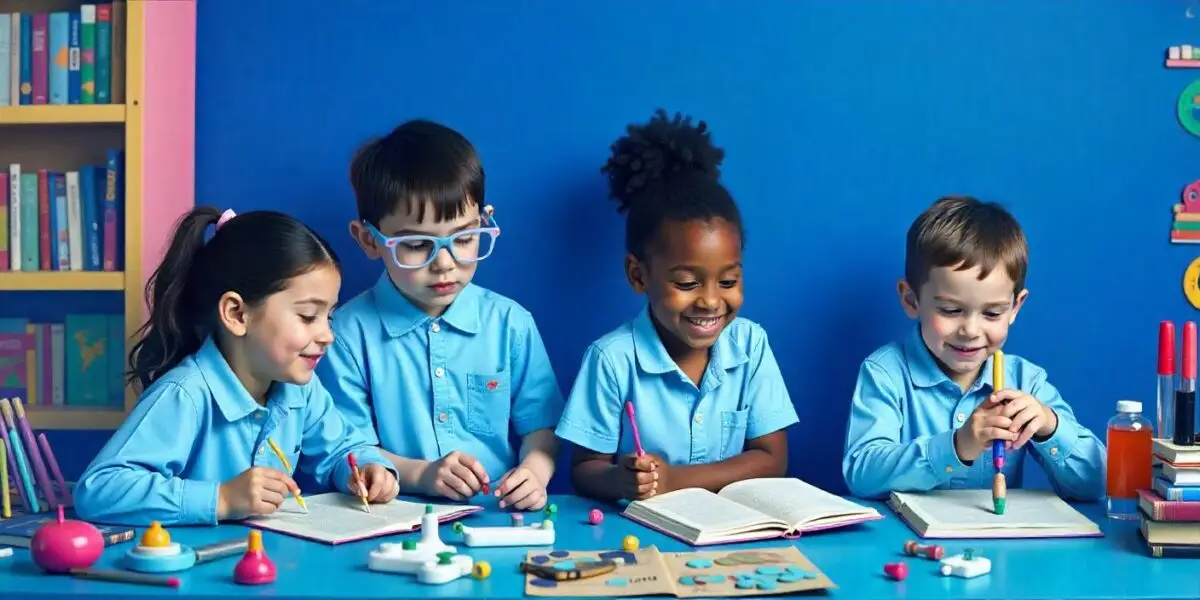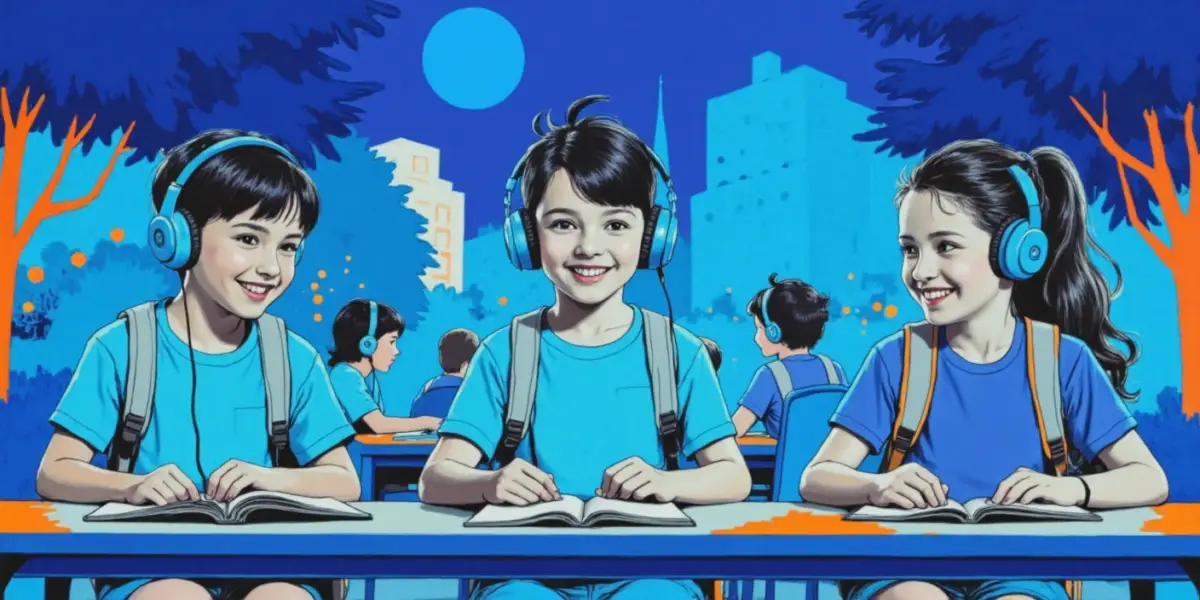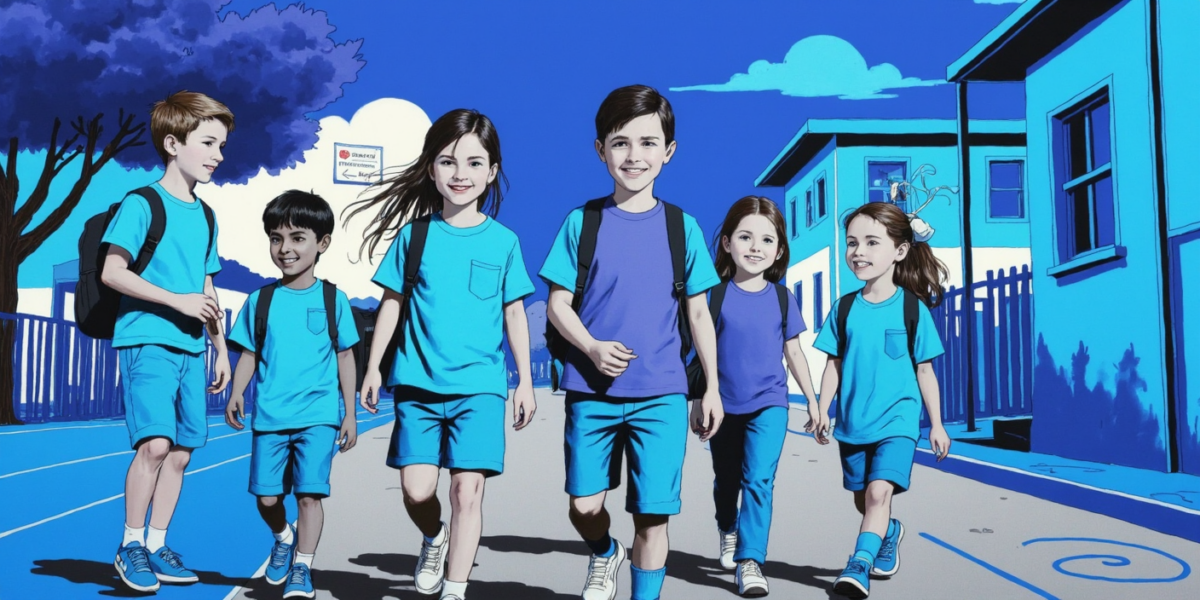The Definitive Guide to Austin’s Best Private Kindergartens
Kelly Davis
on
May 1, 2025
Kelly Davis, 16 Years Teaching, Global Strategy Lead for Education Marketing
Austin’s vibe? It’s this eclectic mix of tech innovation and Texan charm that even seeps into its kindergarten scene. Yep, Austin’s got a kindergarten landscape that’s as colorful as its music scene. It’s like this vast, kaleidoscopic play of options, from faith-inspired spaces to high-tech hotspots, all calling out to parents keen on finding the perfect startup for their little learners. Picking the right one isn’t just about neighborhood convenience; it’s a choice that can seriously mold your child’s future smarts and love for learning. So, let’s turn that dizzying decision into a breeze, shall we?
Take a deep breath! This article is your ultimate guide through the jungle of Austin’s private kindergartens. We’re exploring educational philosophies, revealing key decision points, and spotlighting the crème de la crème of kindergartens. Our goal? To arm you with insights to confidently choose a kindergarten that resonates with your endearing child’s needs, kicking off their educational journey with a smile that screams “I’m ready to learn!”
I. Decoding Austin’s Private Kindergarten Scene
A. A Kaleidoscope of Educational Models
When it comes to choices, Austin’s kindergarten landscape is pretty darn diverse, mirroring the city’s eclectic soul. You’ve got options with educational models that cater to every learning style and family ethos.
- Faith-Based Schools: Here, academics and spirituality intertwine smoothly. It’s like hitting two birds with one stone — you get intellectual as well as moral insights for your kiddo. Is weaving faith into everyday learning part of your compass?
- Montessori Schools: At Montessori, it’s all about self-discovery and exploration. Kids here grow with independence as they wander around hands-on activities and personal learning — a structured freedom, if you will. Is your child the curious, independent type?
- Classical Schools: Classical schools call back to ancient traditions, fostering critical thinking and logic through a beautifully structured curriculum. If you’re into a bit of ancient wisdom rolled into your child’s schooling, this might be your jam.
- Waldorf Schools: Visualize a place where creativity and arts take the driver’s seat. Waldorf schools nurture artistic expression and social skills, focusing more on all-around emotional development. Is fostering creativity and nature-loving instincts your family’s ethos?
- Progressive Schools: These are all about giving kids the tools to think critically and solve problems while learning through hands-on activities. Essentially, it’s “learn by doing” at its best. Does that sound inspiring to you?
- Tech-Forward Schools: With innovation as their middle name, these schools use technology like a trusty sidekick. They personalize learning experiences based on data-driven insights, ensuring that tech-savvy is more than a catchphrase. Keen on a futuristic learning twist?
Finding that magical moment where educational philosophy aligns with your child’s inner world and your family’s values is quintessential. Consider your child’s persona and what environment will ignite their passion while providing a nurturing space.
B. Key Considerations When Choosing a Kindergarten
Navigating through Austin’s private kindergartens isn’t a walk in the park, and there’s more to consider than just educational approaches. You gotta think in an integrated manner.
- Academic Quality and Curriculum: The backbone of a school. Check out schools with a solid standing in core subjects, and delve into their teaching methodologies. Are they just textbook or innovation-driven learning?
- Student-Teacher Ratios: A lower ratio means more focused attention, which can be a huge deal for young ones. Does the school vibe with small-group interaction?
- Tuition Costs: Tuition tags can vary wildly. Dig into what’s included and whether there are financial aids or scholarships that can ease the load on your wallet. Don’t skip the fine print; those hidden fees are lurking somewhere.
- School Culture and Community: Listening to current parents or students can give you vibes about the school culture. Does the school cultivate a sense of belonging and an inclusive environment?
- Extracurricular Enrichment: A peek into the extracurricular world will tell you how schools enrich beyond academics. From arts to sports, what unique experiences can your child delve into?
Understanding these dynamics helps in choosing a kindergarten that syncs with your child’s dreams and learning style, leaving room to flourish.
II. Austin’s Top 7 Private Kindergartens: A Deep-Dive
1. Alpha School
A. Overview
- Grades: K–8
- Founded: 2014
- Enrollment: 152 students
- Student-Teacher Ratio: 3:1
- Tuition: Starting at $10,000
B. Educational Focus
Let’s talk about future-ready learning! Alpha School’s learning machine is powered by AI, creating a personalized pace for each student. Rigorous morning academics blend smoothly into afternoon sessions focused on creativity and entrepreneurship.
C. Pros
- Tailored Learning: The AI platform accelerates learning uniquely for each child.
- Practical Skill-Building: Focus on real-world mastery like public speaking.
- Personalized Attention: Ridiculously good student-teacher ratios.
D. Cons
- Non-Traditional Hours: The pace and schedule might catch some families off guard.
- Pricey Affair: State-of-the-art learning isn’t dirt cheap.
E. Parent Testimonials & Reviews
Parents cheer for Alpha’s fresh approach. One beaming review: “The AI setup at Alpha shot my child’s learning experience to the stars, and now they can’t get enough of entrepreneurship!”
2. St. Andrew’s Episcopal School
A. Overview
- Grades: Pre-K–12
- Founded: 1952
- Enrollment: 973 students
- Student-Teacher Ratio: 8:1
- Tuition: $45,460
B. Educational Focus
St. Andrew’s jumps into the game with a solid curriculum covering English, math, Spanish, and religion while prioritizing empathy through service learning.
C. Pros
- Balanced Programs: Stellar focus on STEAM, arts, and sports.
- Empathy and Service: Cultivates well-rounded, socially aware individuals.
- Evidence-Based Learning: Smart, researched curriculum.
D. Cons
- Hefty Tuition: Sits on the high end, with extra fees sprouting here and there.
- Faith-Centric: Religious elements that might not mesh well with all.
E. Parent Testimonials & Reviews
Parents laud their integrated approach. “St. Andrew’s builds a strong academic base while crafting solid characters,” said one pleased parent.
3. Regents School of Austin
A. Overview
- Grades: K–12
- Founded: 1992
- Enrollment: 1,079 students
- Student-Teacher Ratio: 10:1
- Tuition: $13,696 (Kindergarten)
B. Educational Focus
Following the Trivium model, Regents weaves classical education by focusing on logic and intelligence with impressive academic performance stats.
C. Pros
- Classical Greatness: Deepens intellectual development.
- Expert Faculty: Passionate classical educators onboard.
- A+ Test Scores: Shows through in top-notch national test results.
D. Cons
- Structured Vibe: Could feel stifling for some free spirits.
- Big School: Might mean less individualized attention.
E. Parent Testimonials & Reviews
Parents love this for its rigorous approach. “Regents School drives the love for learning,” says one thankful parent, boosting community vibes.
4. Austin Waldorf School
A. Overview
- Grades: Pre-K–12
- Founded: 1980
- Enrollment: 421 students
- Student-Teacher Ratio: 9:1
- Tuition: $22,000
B. Educational Focus
Here’s where creativity meets nature. Austin Waldorf lets creativity and environmental love intertwine via art-centered and mixed-grade classes.
C. Pros
- Integrated Learning: Emphasis on nature and movement.
- Veteran Teachers: Well-versed in Waldorf methods.
- Eco-Friendly Community: Promotes environmental awareness.
D. Cons
- Play Now, Learn Later: Initial academics take a back seat.
- Costly Specialty: Tuition reflects specialized program features.
E. Parent Testimonials & Reviews
Parents cherish the creative spirits here. “Our child’s creativity bloomed here,” remarks one satisfied parent.
5. Austin Peace Academy
A. Overview
- Grades: Pre-K–12
- Founded: 1997
- Enrollment: 623 students
- Student-Teacher Ratio: 7:1
- Tuition: $8,500
B. Educational Focus
Marrying Quranic studies with a rich college-prep STEM curriculum is Austin Peace Academy’s forte, earning them accolades for STEM excellence in 2020.
C. Pros
- Balanced Learning: A graceful blend of faith and academics.
- STEM Powerhouse: Strong in preparing brilliant STEM minds.
- Close-Knit Vibes: Cultivates a supportive community.
D. Cons
- Faith-Forward: May not be everyone’s cup of tea.
- Fewer Extras: Limited sport and extracurricular offerings.
E. Parent Testimonials & Reviews
Parents treasure the well-rounded approach. One parent mentioned, “It’s a nurturing haven that blends faith with STEM brilliance.”
6. Trinity Episcopal School
A. Overview
- Grades: K–8
- Founded: 1999
- Enrollment: 639 students
- Student-Teacher Ratio: 7:1
- Tuition: $30,800 (Grades K–4)
B. Educational Focus
With an eye on personalized instruction, Trinity tackles education using a research-based lens with two teachers tagging along in K–4 classrooms.
C. Pros
- Personal Touch: Two teachers double the learning magic.
- After-School Fun: Expansive extracurricular range.
- Top-Notch Practices: Grounded in delivering quality education.
D. Cons
- Price Tag: Financially demanding.
- Capped at Grade 8: Requires transitioning post-eighth grade.
E. Parent Testimonials & Reviews
Parents rave about the engaging environment. A parent shared, “Trinity offered a socially vibrant space where my kid blossomed.”
7. Kirby Hall School
A. Overview
- Grades: Pre-K4–8
- Founded: 1976
- Enrollment: Approximately 84 students
- Student-Teacher Ratio: 6:1
- Tuition: $17,875
B. Educational Focus
Championing a growth mindset, Kirby Hall combines tech integration with hands-on experiences for compelling learning.
C. Pros
- Tailored Attention: Intimate class sizes for personalized nurturing.
- Tech Savvy Setup: Ready to ride the digital wave.
- Language Immersion: Spanish language focus that’s right on point.
D. Cons
- Limited Diversity: Smaller student body means fewer perspectives.
- Urban Vibes: Not the best for every family.
E. Parent Testimonials & Reviews
Parents highlight the hands-on learning and state-of-the-art approach. “My child’s love for learning is thriving here,” says one happy parent.
III. Comparison Table: Top Schools at a Glance
School Name | Educational Focus | Student-Teacher Ratio | Grades | Founded | Enrollment | Tuition |
Alpha School | AI-Adaptive Learning | 3:1 | K–8 | 2014 | 152 | $10,000+ |
St. Andrew’s Episcopal | Research-Informed Curriculum | 8:1 | Pre-K–12 | 1952 | 973 | $45,460 |
Regents School | Classical Christian Education | 10:1 | K–12 | 1992 | 1,079 | $13,696 (K) |
Austin Waldorf | Arts-Integrated Learning | 9:1 | Pre-K–12 | 1980 | 421 | $22,000 |
Austin Peace Academy | Islamic & STEM | 7:1 | Pre-K–12 | 1997 | 623 | $8,500 |
Trinity Episcopal | Personalized Episcopal Ed. | 7:1 | K–8 | 1999 | 639 | $30,800 |
Kirby Hall | Growth Mindset & Tech | 6:1 | Pre-K4–8 | 1976 | ~84 | $17,875 |
IV. Other Noteworthy Kindergarten Programs in Austin
These spotlight-worthy programs pack a punch:
A. St. Gabriel’s Catholic School
- Grades: Pre-K–8
- Founded: 1999
- Enrollment: Approximately 433 students
- Student-Teacher Ratio: 8:1
- Tuition: Starting at $6,166
- Highlights: Boasts rigorous Catholic teaching, service-learning, and teamwork honed through sports.
B. Strickland Christian School
- Grades: Pre-K–8
- Enrollment: 142
- Tuition: $4,380–$6,500
- Highlights: Budget-friendly, with a moral guidance focus and family-centric atmosphere.
C. Veritas Academy
- Grades: Pre-K–12
- Enrollment: 676
- Tuition: $3,175–$13,425
- Highlights: Classical Christian excellence, academic stalwart with flexible tuition avenues.
V. Practical Tips for Parents Choosing a Private Kindergarten
- Seamless K–12 Pathways: Long-term, stable school journeys rock.
- Visitation: In-person glances tell you tons about teaching vibes.
- Philosophy Fit: Go for a school whose educational values strike a chord with your family’s beliefs.
- Extracurriculars to Expand: Check out extracurriculars to enrich your child’s school life.
- Ratio Relevance: Watch how small ratios make personalized learning doable.
- Financial Savvy: Mind those tuition digits, financial packages, and extra costs.
VI. Frequently Asked Questions (FAQ)
- Q1: What’s the buzz between Montessori, Waldorf, and Classical education?
- Montessori emphasizes self-guided learning; Waldorf nurtures arts and emotional growth; Classical focuses on building razor-sharp logic.
- Q2: What’s Austin’s private kindergarten tuition landscape?
- Tuitions range from around $8K to $45K, influenced by each school’s focus and resources.
- Q3: When should we get this app rolling?
- Start your scouting months ahead, as schools tend to hold open houses and tours in fall.
- Q4: What should we ask during school tours?
- Look into curricula, teaching techniques, results, as well as parental participation.
- Q5: How do we spot the ‘perfect fit’?
- Consider your child’s flair, learning leanings, and a school’s culture, size, and approach.
VII. Conclusion: Embarking on Your Kindergarten Journey
Switching through the gears in your quest for the perfect kindergarten is a biggie! But guess what? All your hard work? Totally worth it. Austin’s plethora of schools treasures unique strengths and vibes. By carefully assessing these factors, going on school tours, and chatting with folks already in the know, you’ll land on a choice that genuinely supports your child’s learning aspirations. So set sail on this educational adventure, knowing it’ll carve out a thriving space for your child’s inquisitive spirit! Good luck, and have fun with the search!
References
Alpha School. (n.d.). About Alpha School. Retrieved April 22, 2025, from https://alphaschool.com/about
Austin Peace Academy. (n.d.). Welcome to Austin Peace Academy. Retrieved April 22, 2025, from https://austinpeaceacademy.org/about
Austin Waldorf School. (n.d.). Our School. Retrieved April 22, 2025, from https://austinwaldorf.org/about
College Transitions. (n.d.). Private School Guides. Retrieved April 22, 2025, from https://www.collegetransitions.com/private-school-guides
Kirby Hall School. (n.d.). Kirby Hall at a Glance. Retrieved April 22, 2025, from https://kirbyhallschool.org/about
Niche. (n.d.-a). Alpha School. Retrieved April 22, 2025, from https://www.niche.com/k12/alpha-school-austin-tx
Niche. (n.d.-b). Austin Waldorf School. Retrieved April 22, 2025, from https://www.niche.com/k12/austin-waldorf-school-austin-tx
PrivateSchoolReview. (n.d.-a). St. Gabriel’s Catholic School Profile. Retrieved April 22, 2025, from https://www.privateschoolreview.com/st-gabriels-catholic-school-profile
PrivateSchoolReview. (n.d.-b). Strickland Christian School Profile. Retrieved April 22, 2025, from https://www.privateschoolreview.com/strickland-christian-school-profile
Regents School of Austin. (n.d.). Academics. Retrieved April 22, 2025, from https://regentsaustin.org/academics
St. Andrew’s Episcopal School. (n.d.). History & Mission. Retrieved April 22, 2025, from https://saes.org/about/history
Strickland Christian School. (n.d.). About Us. Retrieved April 22, 2025, from https://stricklandschool.com/about
Trinity Episcopal School. (n.d.). About Trinity Episcopal School. Retrieved April 22, 2025, from https://tesaustin.org/about
U.S. News & World Report. (n.d.). Best Private High Schools in Austin, TX. Retrieved April 22, 2025, from https://www.usnews.com/education/private-schools/austin-tx
Veritas Academy. (n.d.). Academics. Retrieved April 22, 2025, from https://veritasacademy.net/academics










